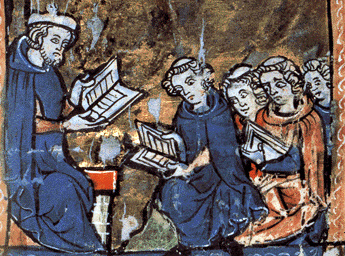Hrólfs saga kraka — chs 34-35 §35.4
Drag the words in the Old Norse text onto the corresponding words in the translation (this won’t work if a translation has not been entered into the database).
|
|
Nú sjá þeir dýrit, ok því næst œpir Hǫttr slíkt sem hann má ok kvað dýrit mundi gleypa hann. Bǫðvarr bað bikkju þá þegja ok kastar honum niðr í mosann, ok þar liggr hann ok eigi með ǫllu óhræddr, ok eigi þorir hann heldr heim at fara. Nú gengr Bǫðvarr í móti dýrinu. Þat hœfir honum, at sverðit er fast í umgjǫrðinni, er hann vildi bregða því. Bǫðvarr eggjar nú fast sverðit ok þá bragðar í umgjǫrðinni, ok nú fær hann brugðit umgjǫrðinni, svá at sverðit gengr ór slíðrunum, ok leggr þegar undir bœgi dýrsins ok svá fast, at þegar stóð í hjartanu, ok datt þá dýrit til jarðar dautt niðr.
|
Now they see the beast and [¤] next Hǫttr cries out as much as he can and says the beast will swallow him. Bǫðvarr then told the bitch to shut up and throws him down into the moss, and there he lies, and not [¤] entirely unafraid, but he does not dare anyway to go home. Now Bǫðvarr goes [¤] against the beast. It befalls him that the sword is stuck in the scabbard when he tries to draw it. Bǫðvarr now urges hard the sword and then there is movement in the scabbard, and now he gets [it] drawn in the scabbard, so that the sword comes out of the sheath, and [he] strikes at once under the beast’s shoulders and so hard that at once it stuck in its heart, and then the beast fell down dead to the earth.
|
35.3Hrólfs saga kraka — chs 34-35Start again
35.5
CloseTeaching text: translation
Here you can test your Old Norse translation skills by connecting words in the Old Norse text with a translation (if a translation has been entered into the database).
Drag with your finger or mouse the words in Old Norse onto the corresponding words in the English translation. If you are correct, the word will stay and the Old Norse word will be highlighted. If you don’t match the words correctly, the Old Norse word will return to its old position.
Note that translations are subjective and there is never a full word-to-word correspondence between the text and translation. If you notice any mistakes in the site, email the database editor. Where a word in the Old Norse cannot been translated directly ‘[...]’ will appear in the translation and corresponds to the untranslated word. Some Old Norse words will have been translated with more than one English word — these appear together in the same box.
